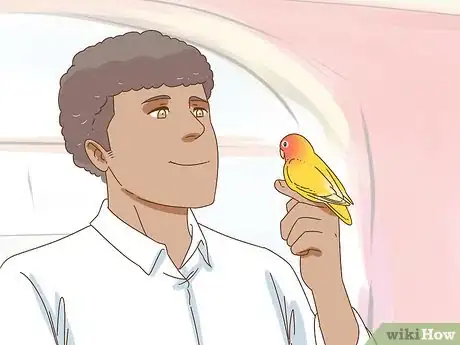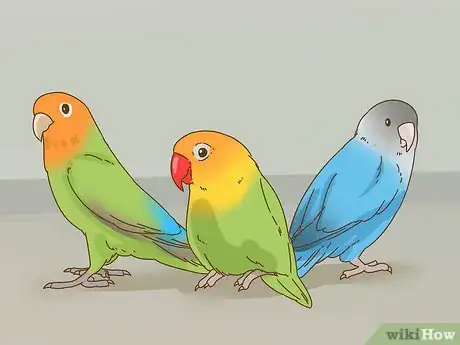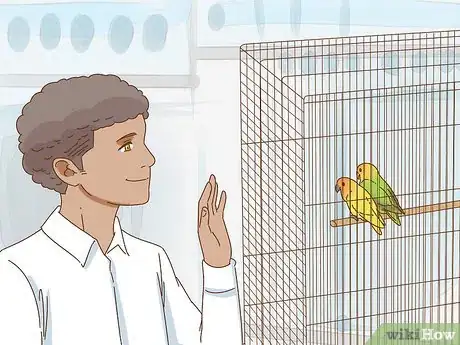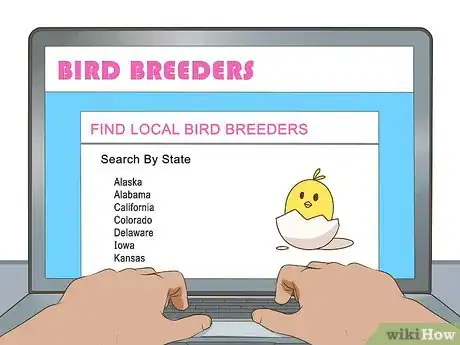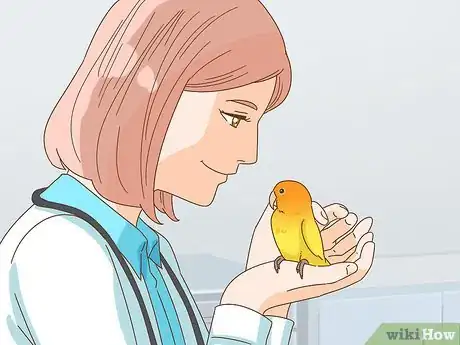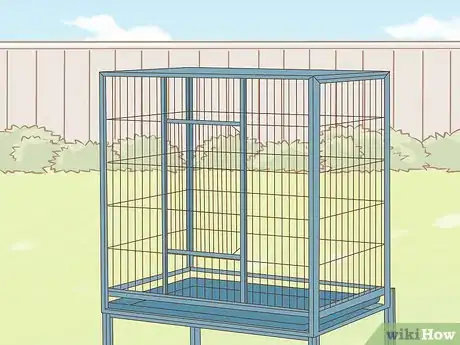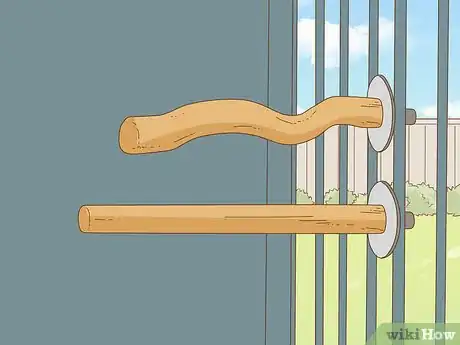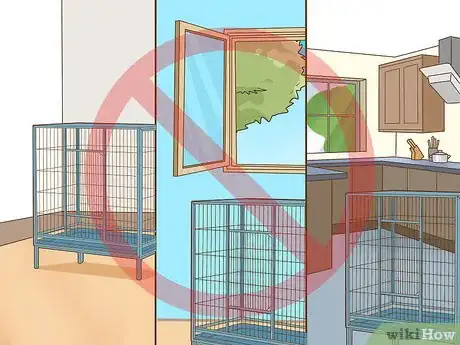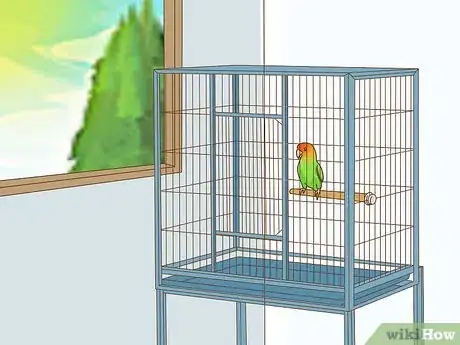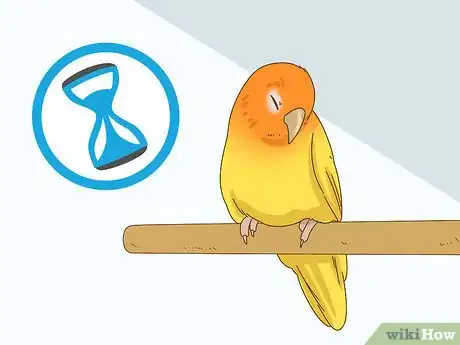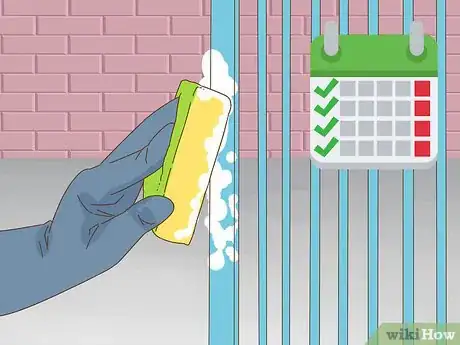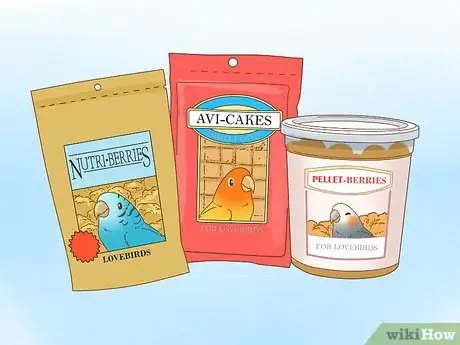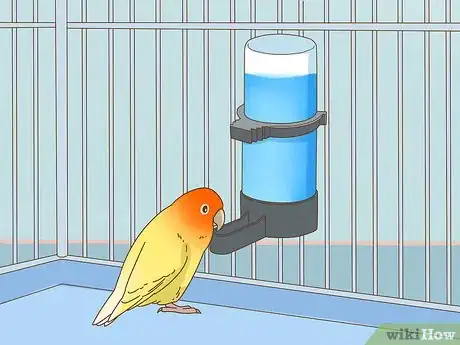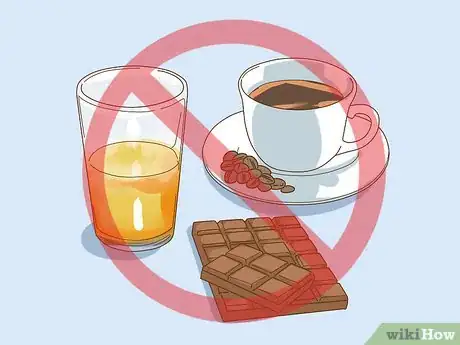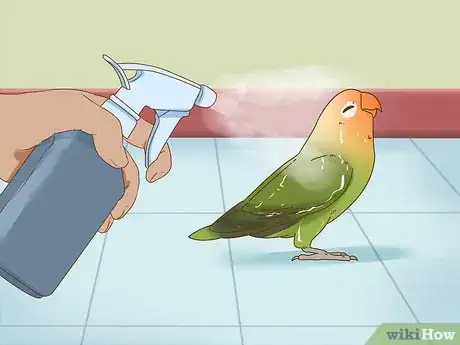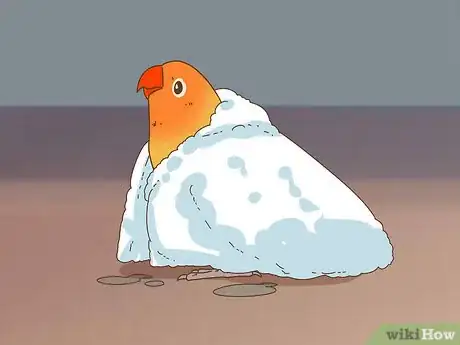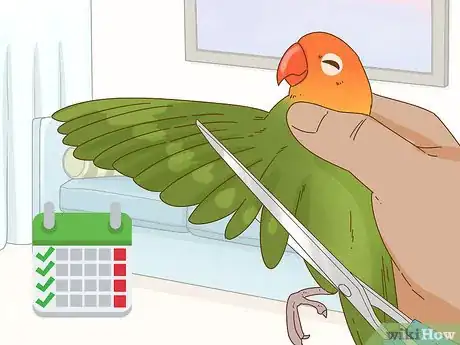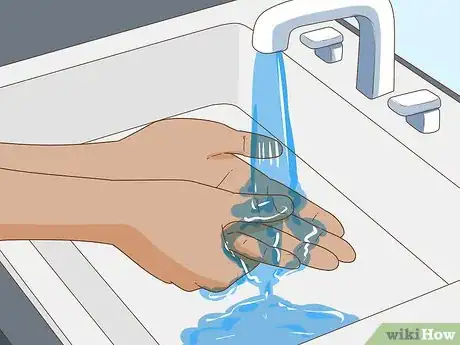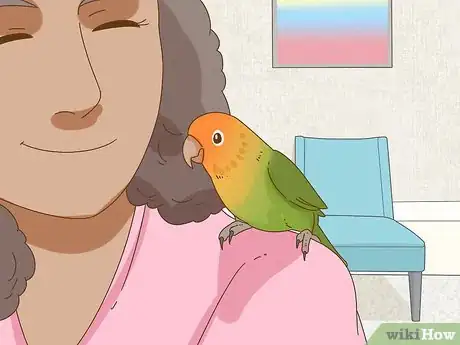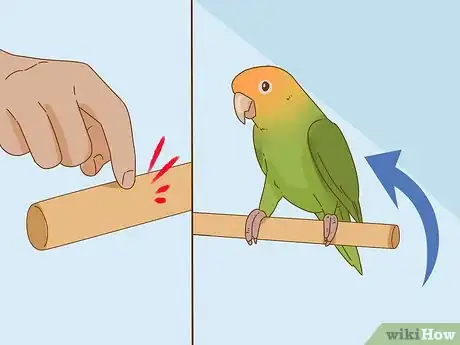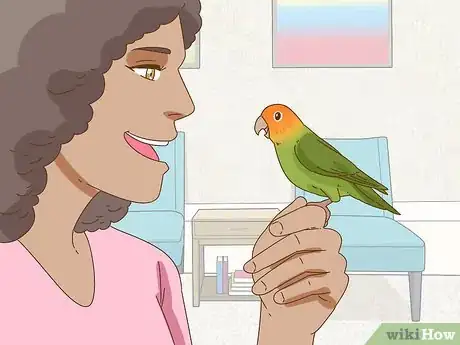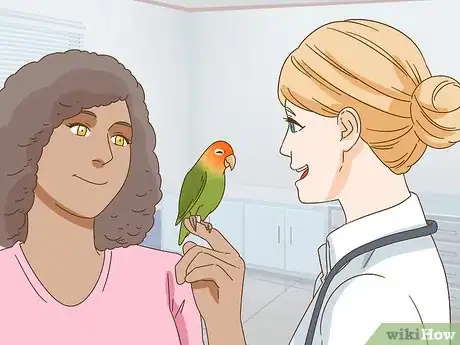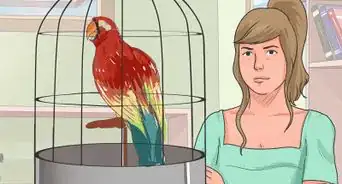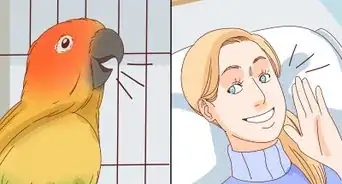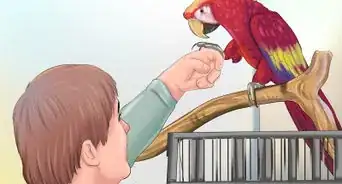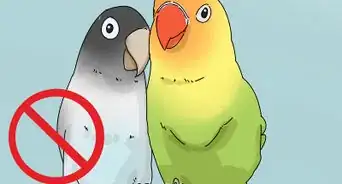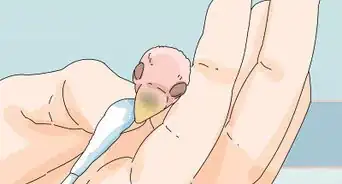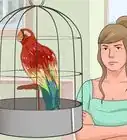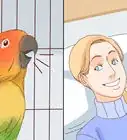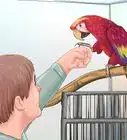This article was co-authored by Pippa Elliott, MRCVS. Dr. Elliott, BVMS, MRCVS is a veterinarian with over 30 years of experience in veterinary surgery and companion animal practice. She graduated from the University of Glasgow in 1987 with a degree in veterinary medicine and surgery. She has worked at the same animal clinic in her hometown for over 20 years.
There are 7 references cited in this article, which can be found at the bottom of the page.
wikiHow marks an article as reader-approved once it receives enough positive feedback. This article received 19 testimonials and 80% of readers who voted found it helpful, earning it our reader-approved status.
This article has been viewed 456,138 times.
Lovebirds are little parrots with colorful plumes and fun personalities. As pets, these little birds are devoted and playful with their owners. With the appropriate care and attention, a lovebird can live for 8 to 12 years, or longer. One common myth surrounding keeping lovebirds as pets is that they need to be kept in pairs for their own wellbeing, otherwise they will suffer or die. In fact, most lovebird breeders argue for keeping lovebirds as single pets, with the owner acting as the lovebird’s flock.
Steps
Buying the Lovebird
-
1Don’t worry about buying more than one lovebird or bonding your lovebird to another lovebird. Contrary to popular belief, keeping lovebirds as a single pet is not frowned upon by breeders and experts so don’t be too concerned about purchasing more than one lovebird at a time. In fact, introducing another lovebird to your lovebird at a later date can be dangerous, as the older lovebird may try to harm or kill the new bird. Another risk of keeping more than one lovebird is that the birds will want to bond with each other, rather than you, their owner.
- If you do want to keep more than one lovebird at a time, introduce the bird when they are both very young or work on one at a time so they bond to you and then to each other. Groups of lovebirds create social hierarchies, so there is one alpha bird and every bird follows the alpha.
- Another common myth is that lovebirds can be mean or aggressive, especially female lovebirds who are marking their territory or their cage. Most breeders agree that male lovebirds make better pets, though males can also show territorial behavior and chirp at any fingers that enter their cage. Most lovebirds, male and female, have mild temperaments. To counteract any aggression from them, it’s important that you train your lovebird to prevent nipping.
-
2Become familiar with the different lovebird breeds. There are many different breeds of lovebirds, but the three most popular breeds are:
- Peach-faced lovebirds: These little birds are the most commonly kept breed. They stand at 5-inches tall, with green and blue plumes, and have a rosy colored face. Peach-faced lovebirds have been bred into hundreds of color mutations, from pure white albino birds to deep purple birds.
- Masked lovebirds: This breed has eye-rings, a black mask, an orange beak, yellow chest feathers, and green wings. Some breeders consider masked lovebirds more aggressive than the two other more common breeds.
- Fischer’s lovebirds: Also known as eye-ring lovebirds, as they have a white ring around their eyes. They are smaller than peach faced and masked lovebirds and have a distinct, high pitched chirp. Most breeders agree that Fischer’s are more aggressive than the peach-faced lovebirds or masked lovebirds.
Advertisement -
3Go to a rescue. Rescues are filled with birds who need good homes every year. They have birds who are expensive to keep, so a little help would be very well appreciated. You get to interact with the bird way more at a rescue than a pet store or a breeder, and pet stores like PetSmart and PetCo often sell birds who are sick or lower in quality because they need to push birds out the door. They also often sell bird seed or fruity pellets, which means they don't know about birds. Big brand pet stores are not a good place to get a bird because that encourages pet stores to sell more birds and more wrong information.
-
4Look for a lovebird at your local pet store. Most local pet stores have lovebirds for sale, likely peach faced and Fischer’s lovebirds. Before you buy the lovebird, check that:
- The bird looks healthy. The bird should be perky, active, and alert with bright clear eyes. They should also have a clear cere, or fleshy nose area, and nares, or nostrils. You can't see the nostrils usually on some lovebirds. Ask someone to even check if the lovebird is healthy.
- Watch the bird eat and drink to make sure the bird has an appetite. The bird should also be well groomed with neat, bright feathers. The feathers should be mostly smoothed to the body, not fluffy or raised. If they are, the bird is one out of four things. Either sick, cold, protecting something, or angry. So think twice. The bird’s feet and legs should be smooth and free of lumps, scabs, and rough scales.
- The bird should vocalize with you in chirps, clicks, and whistles. Most lovebirds are excited to communicate with new faces, though some bird can be shy or intimidated around new people. A healthy bird will be confident and inquisitive, but cautious and aware as well.
- If possible, ask to hold or touch the bird. Make sure the bird is interested in interacting with you and does not bite or hurt you. This may be a sign the bird is aggressive. If he just nibbles your finger, he is just checking you out to see if he likes you. Stay calm!! You get used to it over time, and as long as it doesn't hurt, it's fine.
-
5Search online for lovebird breeders. There are several databases of lovebird breeders available online that you can search based on your state or area and your preferred breed.[1] Be wary of overpriced birds and always contact the breeders directly to establish a rapport before you buy a bird from them.[2]
- Most reputable breeders hand-raise their birds. This means they are involved in every stage of breeding, from choosing the mates to creating a good breeding environment in a cage to maintaining the birds’ diet and nutrition.
- Breeders will also carefully watch over the eggs and take care of the babies until they have found suitable homes. Some breeders will hand-feed the babies to tame them and wean them off of their parents. Hand-feeding and hand-taming the babies are also good ways to get the birds used to human interaction. This makes most hand-raised lovebirds very tame and loving pets.
- Hand-raised Lovebirds can range in price from $40 to $130 for the more common species and mutations. Hand raised or hand fed lovebirds mean that they were raised by people and taken care of by people. Parent-fed lovebirds from a pet store are generally less expensive. But the rarer species and mutations will be more expensive than the more common species.
-
6Take your new lovebird to the vet. An avian vet is important because birds can pick up health problems that may not be obvious to you, so bring your new lovebird to a vet to confirm the bird is healthy.
- If you know you are going to be buying a lovebird in the near future, schedule a vet appointment for right after you pick up the bird from the store or the breeder.
- You should choose an avian vet for your bird. A normal vet doesn't specialize in birds and may have not dealt with birds before.
- For an additional fee, the vet can create a wellness plans to help your lovebird live a long, healthy life. These plans include annual health check ups and emergency medical care.
-
7Consider confirming the sex of the lovebird. Lovebirds are not sexually dimorphic, which means you generally cannot tell if a lovebird is a male (a cock) or a female (a hen) just by looking at the lovebird. The best way to confirm the sex of the lovebird is to have your vet do a DNA test, or to conduct one yourself with a DNA kit.[3]
- A DNA kit usually costs between $15 and $22. You will need to clip one of your bird’s toenails a little higher than you normally would and send the sample to the lab. Consider if this would hurt or make your lovebird uncomfortable. It would use its defence and bite, and that might leave a small mark and pain on your skin. If it is bleeding, make sure to wash and bandage it.
- The vet can also take the sample for you and send it to the lab for testing.
- Some visual differences between the sexes exist, as hens tend to have a wider stance on the perch, they are a bit larger than cocks, and they have wider pelvic bones that you can check gently with your index finger.
Housing the Lovebird
-
1Look for a cage that is at least 18” long by 18” by 18". However, the bigger the better. Lovebirds are active, playful birds so they need a cage that will accommodate all the toys and perches they need to keep them busy. Avoid cages and bird products in general from China, because those cages might have toxins and lead. The best cages are made from stainless steel but those are very expensive so most go with powder coated iron, which is okay too, but stainless steel lasts longer and is less expensive in the long haul since powder coating chips so you need to replace it. Galvanized metals are toxic. But the best thing you can get your bird is an aviary. They can be expensive, but it will be appreciated. Good aviary brands are Corner's Limited, a cage and aviary manufacturer that makes their cages in the USA.[4]
- The cage should also have horizontal bars on at least two sides. The bar spacing should be 1/2 inch apart to prevent injury. Some birds have gotten their foot stuck and have had to chew it off or their head stuck and died from a heart attack.
-
2Use perches of different widths, diameters, and textures in the cage. The cage should have at least two or three perches of various sizes, shapes, and textures to help your bird’s feet stay healthy and strong. The perches should be thick enough for the bird to stand comfortably on them without losing her balance. The smallest perch should be about ½” in diameter.
- Look for perches made from natural wood branches, concrete and pumice, and paper rope. Cotton rope can fray and be digested or hang your bird. The dowels that come with your bird hurt your bird's feet. [5]
-
3Keep the bird’s cage off the floor and away from drafts, open windows, and the kitchen. Your bird’s cage should be raised and kept away from air vents and doorways. Some birds can catch a cold if exposed to a draft while they are wet, such as after a bath[6]
- Lovebirds can be sensitive to smoke and strong odors, as well as loud noise.[7] If you smoke, do not smoke in your house. Getting a HEPA air filter would be great for you and your bird.
-
4Place the cage in a quiet, well lit room. A room that is too dark may cause your lovebird to behave oddly and develop health issues. But you should not place the cage near a window that gets full sun during the hottest months of the year as this may cause heat stroke or death for your little bird.[8]
- Weak, unfiltered sunlight on the cage is ideal as this gives your bird vital ultraviolet-B light to keep her healthy. If your lovebird’s cage is near a window with weak light, you may want to consider investing in a special light bulb that emits safe levels of ultraviolet-B light to hang over your lovebird’s cage. You can turn on the light for 8 to 10 hours a day to make sure your bird gets enough light.[9]
-
5Make sure your bird gets 10-12 hours of uninterrupted sleep every night. Sleep is important for lovebirds. If you are going to keep your lovebird in a cage indoors, you may want to get a cover for the cage to help your bird sleep at night.[10]
- You can also get a smaller sleep cage for your bird if you don’t have enough space for a large cage indoors. Using a sleep cage will ensure your bird has a quiet, safe place to sleep.
- You should put your lovebird to bed at the same time every night and bring her out of her sleep cage the same time every morning.[11]
-
6Clean your bird’s cage once a week. The tray and dishes in your bird’s cage should be cleaned every day with hot soapy water and a clean toothbrush.[12] [13]
- Use warm water and soap. Remove your bird from the cage and wipe down the cage, the perches, and any toys in the cage.
- You can also use a product called Cleansing Gel to do a deep clean of the cage. This cleaner contains stabilized chlorine dioxide and is safe for birds.[14]
- Be careful when using a diluted bleach solution to disinfect the cage. Bleach is toxic to birds. So rinse the cage thoroughly after you use a bleach and water solution. Then, place the cage in the sun to air dry.[15]
- Be certain the cage and bowls are free of any bleach smell before you place your bird back in the cage.
Feeding the Lovebird
-
1Give your bird high quality pellets. Popular brands are Harrisons, Tops, Roudybush, Goldenfeast, and Zupreem. Harrisons has sunflower seeds as their first ingredient, which aren't good for your bird as their diet. Roudybush has corn as it's ingredient, and Goldenfeast has sunflower seeds. Zupreem's colored pellets are filled with fruit and sugar, but their natural pellets have corn. Tops has rice, barley and alfalfa. Tops also is special because it's cold pressed which means less nutrients are lost. However, doing your own research and finding a good brand with no filler, color, or fatty ingredients is key.
- Birds should have sixty percent vegetables. A chop of vegetables is the best your bird can have. Some vegetables are toxic to your bird, however. Getting your veggies from a farmers market is best, but going to your local grocery store and buying organically and rinsing them well can do. Avoid buying from Chile, Mexico, and Peru, where food regulations are low.[16]
-
2Give your bird healthy fruits like apples, grapes, berries, papaya, and mango. You should also feed your bird vegetables like carrots, broccoli, zucchini, squash, cooked sweet potatoes, and dark leafy greens like kale and romaine.[17]
- Nuts should be reserved for training. Fruits and legumes should be given three times a week, grains and pellets should be given in daily portions, eggs and snacks should be limited to twice a week, and avocado, alcohol, chocolate, onions, parsley and other things should be never offered to your bird at all.[18]
- It’s fine if your lovebird shares many of the foods you eat. But limit her consumption of fried, greasy, sugary, and salty foods so she stays healthy.
-
3Make sure your bird has access to clean, fresh water throughout the day. Do not give your bird tap water or unfiltered water. Stainless steel or ceramic bowls are best because germs can stick to plastic easily.[19]
-
4Never give your bird alcohol, chocolate, or caffeinated beverages. These substances can kill your lovebird, even in small amounts.[20]
- You should also avoid giving your bird avocados, rhubarb, asparagus, onions, raw legumes like beans and peas, and dairy products.
Grooming and Training the Lovebird
-
1Give your bird a bath every day if possible. Regular bathing is important for keeping your bird healthy and free of disease. If lovebirds are not bathed, their feathers can get ragged or dirty and their dander can be overwhelming.[21]
- Use a fine mist sprayer filled with water to shower your lovebird. Spray lightly a foot or two above your bird so the water droplets drift down like rain.
- Do this a few times so your lovebird gets used to the “rain” and starts to preen and groom herself.
- Some birds love to bathe and will happily hop into a small ceramic dish filled with water. Your bird may also splash around in the water for several minutes.
-
2You should let your bird preen itself and dry naturally. A heater or a hair dryer can contain teflon, or non stick coating which can kill your bird. Non stick pans can kill your bird so throw those out in favor for stainless steel ones. Toweling your bird off can damage its feathers and oil, so letting them dry off will be just fine.[22]
-
3Clipping your bird is a controversial topic, but it is not recommended. Clipped birds can still fly with the right gust of wind and if you clip your birds they have more power to slam into the ground. The best thing to do is indoor flight train your bird if it's smaller than a sun conure and be careful around doors. Recall training a bird (getting a bird to fly to you on your first command) is safer. If your bird lands up a tree or gets attacked by a cat when the day they escape finally comes, it'll be much safer to flight train your bird so it can defend itself.[23]
- You should also trim your bird's toenails to keep her feet normally shaped. This will help her grip on the perches in her cage and reduces the chance of her toenails snagged on clothing or fabric. If you are uncomfortable with trimming her nails on your own, let a qualified professional give her a nail trim.
-
4Use bird-safe toys or create home-made toys. You can get bird-safe toys at your local pet store. You can also make simple toys with wads of clean toilet tissue stuffed in a small box, or leaves and branches from safe plants like rose bushes, hibiscus bushes, and mulberry trees. Toys shouldn't be made of plastic as those can have sharp edges. Leather can poison them, cotton rope can strangle them, and non vegetables dyes are dangerous. Some wood and metals are dangerous for birds.
- Do not place a mirror in your bird’s cage as lovebirds will treat its reflection as a mate.[24]
- Rotate the toys in your bird’s cage on a constant basis so your bird does not get bored of them. Replace any toys that are worn or damaged, as they can injure your bird.
- Always introduce a new toy to your bird in a neutral location before you place the toy in her cage so she can get used to it.
-
5Wash your hands before and after you handle your bird. Germs that your bird carries can be transmitted to humans, and vice versa, and this can cause serious illnesses for you or for your bird.
-
6Take your bird out of her cage for play on a daily basis. Do this in increments of 30 minutes throughout the day to keep your bird well-socialized. Most birds enjoy hanging out on their owner’s shoulder, snuggling up to their necks, or hiding clothing like sweaters or scarves.[25]
- When lovebirds get bored, they tend to chew on clothing and jewelry and pull off buttons. Protect your clothes when your bird is out of her cage by wearing clothing that do not pull. You should also avoid wearing any necklaces when your bird is with you.
- There are “birdie necklaces” available made from bird-safe chain with small bird toys attached to the links that you can wear so your bird has something safe to play with.[26]
-
7Train your bird to “step up” onto a perch in her cage or a toy. Do this by tapping on the toy and gently instructing her to step up. This training will help to control any territorial behavior, which usually occurs when your bird reaches sexual maturity. During this time, your bird may bite any object that comes near her nest area or the cage.[27]
- Teaching her to step up will help her move away from her territory without biting and help her to calm down.
-
8Interact with your Lovebird. Lovebirds are intelligent and sweet birds and tend to get along well with people. They can “talk” like other parrots, though they do not have extensive vocabularies. Engage your lovebird by talking in low tones and encouraging your bird to respond to you or repeat your words.
- Birds can be scared to death, which is why desensitization is so important. You can desensitize your bird to the point of them being calm around vacuums, garage door openings, and even loud music.
- Predatory animals such as cats, dogs, and ferrets should never have direct contact with your bird. Their saliva has germs that can kill your bird and their claws and mouth are obviously dangerous.
-
9Take your bird to the vet on a consistent basis. Most birds will hide their illness until it is in an advanced stage. So it’s best to take your bird to your vet often so she can check for any early signs of illness or potential medical issues.[28]
References
- ↑ http://www.birdbreeders.com/
- ↑ http://www.parrotparrot.com/lovebirds/breeding-lovebirds/
- ↑ http://www.parrotparrot.com/lovebirds/breeding-lovebirds/
- ↑ http://petcaretips.net/lovebird.html
- ↑ http://petcaretips.net/lovebird.html
- ↑ http://www.thatpetplace.com/lovebirds-article
- ↑ http://www.thatpetplace.com/lovebirds-article
- ↑ http://www.thatpetplace.com/lovebirds-article
- ↑ http://www.thatpetplace.com/lovebirds-article
- ↑ http://www.thatpetplace.com/lovebirds-article
- ↑ http://www.thatpetplace.com/lovebirds-article
- ↑ http://www.thatpetplace.com/lovebirds-article
- ↑ http://petcaretips.net/cleaning-bird-cage.html
- ↑ http://petcaretips.net/cleaning-bird-cage.html
- ↑ http://www.thatpetplace.com/lovebirds-article
- ↑ http://www.thatpetplace.com/lovebirds-article
- ↑ http://www.thatpetplace.com/lovebirds-article
- ↑ http://www.thatpetplace.com/lovebirds-article
- ↑ http://petcaretips.net/lovebird.html
- ↑ http://www.thatpetplace.com/lovebirds-article
- ↑ http://www.thatpetplace.com/lovebirds-article
- ↑ http://www.thatpetplace.com/lovebirds-article
- ↑ http://www.parrotparrot.com/lovebirds/tutorial-on-trimming-wings/
- ↑ http://www.thatpetplace.com/lovebirds-article
- ↑ http://www.beautyofbirds.com/lovebirdpets.html
- ↑ http://www.beautyofbirds.com/lovebirdpets.html
- ↑ http://www.thatpetplace.com/lovebirds-article
- ↑ http://www.thatpetplace.com/lovebirds-article
About This Article
To keep a lovebird as a pet, start by placing its cage in a quiet, well lit room since a dark room can cause your lovebird to develop health problems. Then, feed it 2 to 3 teaspoons of pellet or seed based bird food a day, along with fruits and vegetables like apples and carrots. Additionally, make sure that your bird always has access to fresh water, ideally through a water attachment on the cage. In order to keep your bird well-socialized, play with it in 30 minute increments throughout the day. For more tips from our Veterinary reviewer, like how to train your lovebird, read on!
